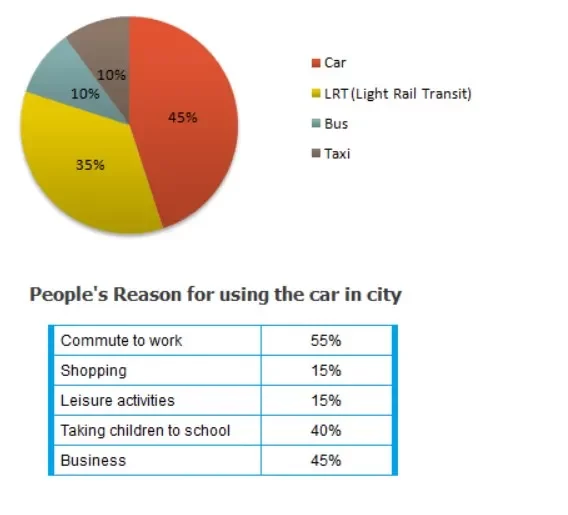You should spend about 20 minutes on this task.
The diagrams below give information on transport and car use in Edmonton. Summarise the information by selecting and reporting the main features, and make comparisons where relevant.
Write at least 150 words.

Sample Answer 1
The table shows why people in Edmonton use their cars in the city, and the pie chart explains what type of transport people prefer to use most of the time.
Looking at the pie chart first, it is clear that the car is the city’s most popular means of transport. 45% of the people say that they prefer to commute by car. The second most popular form of transport is the LRT, while buses and taxis are the primary means of transport for the rest of the people.
The table gives more detailed information about why people use their cars. Surprisingly, 55% of people need to commute to work by car. Cars are also used to take children to school or for business purposes. Only 15% of drivers are doing their shopping; similarly, 15% need to travel by car for leisure.
Overall, people in Edmonton make good use of alternative methods of transport, but there is a heavy dependence on cars for work.
Sample Answer 2
The pie chart portrays the different types of vehicles used in Edmonton and their usage. The table shows the various reasons for using a car in Edmonton.
The car is the most popular form of transportation in Edmonton, followed by Light Rail Transit. Also, the primary reasons for using cars in this city are daily routine tasks and business.
The utilization of a car in Edmonton is the highest among any other mode of transportation, with 45% of the traffic being cars. The second most preferred mode of travel is the Light Rail Transit, with 35% usage. Buses and taxis are the least used and only contribute 10% each to the total traffic.
55% of people in Edmonton commute to work by car, making it the chief purpose of using a car in the city. 45% of the population use cars for business purposes, whereas 40% use them to take their children to school. Cars are used for leisure activities or shopping by 15% of people.
